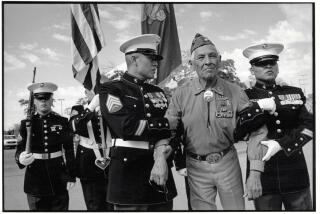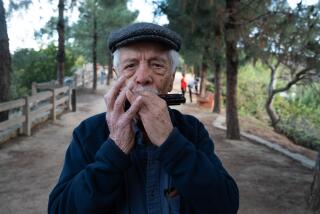Sus Ito’s WWII photos reveal daily life of a little-known Japanese American unit

Sus Ito stands before his exhibit, “Before They Were Heroes: Sus Ito’s World War II Images,” at the Japanese American National Museum in Los Angeles. Ito, 95, served in the segregated Japanese American 442nd Regiment during World War II and took pictures of life on the front.
Just two weeks shy of his 96th birthday, a dapper Susumu “Sus” Ito strolls easily around an exhibition of his work at L.A.’s Japanese American National Museum in Little Tokyo wearing a bright gingham shirt, a gardenia peeking out from the lapel of his sport coat.
Memories come flooding back as he walks past his photographs, taken when he was a soldier during World War II: the ornery mule his unit encountered somewhere along the border between Italy and France. The weary peasant couple standing outside their bullet-strafed home. The fellow serviceman who playfully covered his face when Ito attempted to snap his portrait in the middle of the Vosges Mountains in France.
“I can’t stop looking at some of these,” exclaims Ito joyfully. “I’m seeing some of them for the first time!”
Ito’s pictures offer an intimate view of daily life in the middle of one of the 20th century’s most epic conflagrations. But they are remarkable for another reason, too. The photographer was part of the U.S. Army’s 442nd Regimental Combat Team, a segregated unit made up of Japanese American soldiers.
As many of their families sat imprisoned in internment camps in the United States, this group of young men fought eight major European campaigns. They also led the daring rescue of a group of nearly 300 U.S. soldiers — the “Lost Battalion” — which had been surrounded by the Germans in the Vosges. In the process, the 442nd became the most decorated unit in U.S. military history, a title it holds to this day.
Through it all, Ito was taking pictures (despite the fact that he wasn’t supposed to have a camera on him at the front). And he has donated his vast archive — which consists of thousands of images — to the Japanese American museum, where a selection of several dozen pictures went on view this week as part of the exhibition “Before They Were Heroes: Sus Ito’s World War II Images.”
“These images, I had stacks of them in boxes and albums cluttering up the place,” says Ito. “I’m glad to give them to a museum instead. They’ve digitized many of the images.”
For the museum, the archive is a boon.
“It covers a gap in the imagery of World War II,” says Lily Anne Welty Tamai, the Japanese American museum’s curator of history. “We don’t just see white soldiers. We see Asian American soldiers sitting in cafes with Italian and French women. We see Asian American men holding the American flag. We see some of the only images of Asian American men in combat during the war. Asian Americans can be so invisible. That’s what makes this so important.”
The museum has even made images out of decades-old negatives that Ito had never gotten around to printing.
“What they have done,” he says, “is awesome, to say the least.”
During the war, Ito says, Europeans were often stunned to see a regiment of Japanese soldiers in American uniforms roll into town. “Sometimes when Germans were captured,” he recalls with a belly laugh, “we’d tell them, ‘Don’t you know that Japan is fighting with the U.S. Army now?’”
Certainly, Sus Ito didn’t set out to become an important chronicler of war.
The American-born son of Japanese immigrants who worked as sharecroppers in Stockton, the early years of his life were set to the rhythms of agriculture: the planting and harvest of crops such as celery, asparagus and corn.
A mischievous student in elementary school (one particularly good tale involves the young Ito coming to class with his pockets stuffed full of grasshoppers), he had straightened out by high school, and was even accepted to UC Berkeley. But concerned that his Japanese heritage might be a hindrance, Ito’s parents pushed him to do something more practical.
“I was a good mechanic,” he says, “so I focused on that.”
Drafted in 1940, he spent much of the early war years as a motor sergeant in Riverside. But the job, he says, was terribly boring: “You’re just taking care of trucks and cars and assigning drivers.”
When the opportunity arose to join the 442nd as a forward observer, he jumped on it.
“My mother didn’t want me to do anything dangerous, which is why I probably did it,” he says.
Among the belongings he took to Europe was an Agfa Memo, a 35-millimeter camera that fits neatly into the palm of the hand. It was cheap, with limited focus and zoom capabilities, but it was easy to transport. “I wanted to take one because we weren’t allowed to,” says Ito with a wry grin. “I like to break the rules.”
But, surprisingly, the camera was never confiscated — and somehow Ito made it from Newport News, Va., to Italy’s Adriatic Coast with the little Agfa tucked safely into the front pocket of his field jacket.
As a young man, Ito had always been into photography. Though what he enjoyed about it is something he can’t quite articulate. “I just love it,” he says. “And I like to do things I enjoy.”
Ito spent his entire deployment in Europe — which began in 1944 and lasted through the war’s end — taking pictures. Among the photos on view at the Japanese American museum are images of a serviceman holding a puppy, a group of strapping, Japanese American GIs sitting shirtless before their tent, a zigzagging mountain road, a pair of smiling young children in some unnamed European village, and various scenes of Rome.
Ito would load the cartridges with film under his blankets at night so the film wouldn’t become exposed and then wrap them carefully in tin foil for safe-keeping. “Then I’d get them developed along the way,” he recalls. “Photo shops pop up like magic when you liberate a town.”
He would then send the developed negatives to his parents, who were being held at the Rohwer internment camp in Arkansas.
Ito, having spent the war in the military, was never interned himself. But his father, mother and two sisters were. During basic training at Camp Shelby in Mississippi, he had an opportunity to visit them at Rohwer, a few hours away. While he was there, naturally, he took plenty of pictures, including images of his family sitting before their military-style barracks. (These are also on display at the Japanese American museum.)
“They had a positive attitude about it,” he says of the way his family dealt with internment. “They saw it as something they would just have to endure for the course of the war.”
And the fact that he was fighting for a country that had imprisoned his family? “Well,” he says nonchalantly, “it was ironic.”
In his European images, Ito captures plenty of charming moments and picturesque scenery, but he also records the grittiness of war — which began to wear on the soldiers as their deployment wore on.
During the unit’s first skirmish, along the Italian coast, a high school classmate of Ito’s was killed. “I was shocked,” he recalls. “I was like, ‘This is for real now.’”
Many of Ito’s pictures record aspects of this violent reality. There are the photos of the dazed-looking soldiers of the Lost Battalion, who had somehow fended off the Germans until help had arrived. There are the silhouetted outlines of refugees fleeing the violence. And there is the image of Adolf Hitler’s bombed-out Bavarian retreat.
Some of the most powerful photos capture concentration camp prisoners in the wake of their release. One man, clad in stripes, smiles deliriously into the camera’s lens.
Ito was part of the 522nd Field Artillery Battalion (a subdivision of the 442nd, which was sent into Germany toward the end of the war). The battalion was the first to arrive at some of the sub-camps at Dachau.
“To suddenly see the prisoners in the stripes,” says Ito, “it was....”
For the first time in our interview he is unable to find words to express what he saw.
He prefers to tell the story of his friendship with Larry Lubetski, a Lithuanian Jew who had been interned at Dachau and who came to work as a fixer for the battalion. He and Ito ended up becoming lifelong friends.
“Larry was a teenager,” he says. “He helped us a lot. He could talk to the natives about supplies, and he helped us with the politics of getting along in that area.”
A picture of Lubetski hangs prominently in the gallery.
After the war, Ito moved to Cleveland, where his family had settled upon their release from internment. He attended college, where he became obsessed with biology. And, for more than half a century, he had an extraordinary career as a cell biologist — spending much of it as a researcher and professor at Harvard Medical School. (“Thank God for the G.I. Bill,” he says.) He also married (his wife, Minnie, died three years ago), had four children and is now the grandfather of five.
Despite the fact that 70 years have gone by since the end of the conflict, World War II is something he still carries with him.
The battle in search of the Lost Battalion was a bloody one, in which Germans and Americans fought it out — practically hand-to-hand — in the foggy, mountainous forests of the Vosges. “Even today, if I go into a forest at sundown,” says Ito, “I still get goosebumps down my back.”
When he shipped out to Europe in 1944, Ito took with him three important objects: his camera, a small Bible, and a Senninbari, a Japanese belt given to soldiers on their way to war. His mother had crafted this traditional protective amulet out of a bleached flour sack — the only material available to her in the internment camp. Ito never wore it in the field, since he was worried that it might raise eyebrows among his superiors. But he dutifully carried it in his pocket wherever he went.
“How did I stay safe when so many colleagues died?” he asks. “I accept the possibility that the Senninbari protected me. I give credit to my mother’s love.”
That Senninbari is also now part of the permanent collection at the Japanese American museum.
“Before They Were Heroes: Sus Ito’s World War II Images” is on view at the Japanese American National Museum through Sept. 6. 100 N. Central Ave., downtown Los Angeles, janm.org.
Find me on Twitter @cmonstah.
More to Read
The biggest entertainment stories
Get our big stories about Hollywood, film, television, music, arts, culture and more right in your inbox as soon as they publish.
You may occasionally receive promotional content from the Los Angeles Times.







